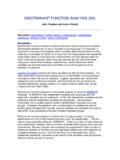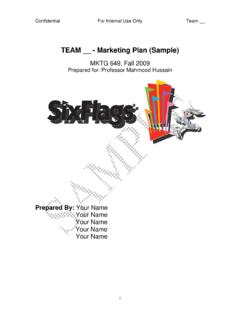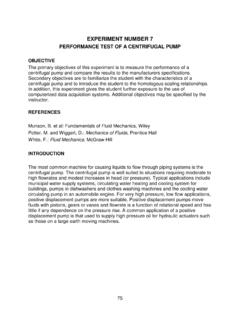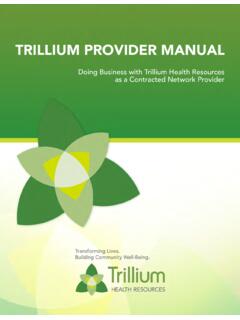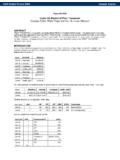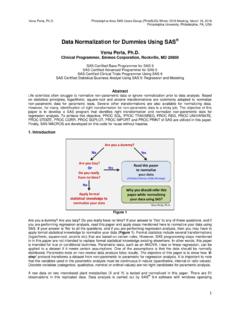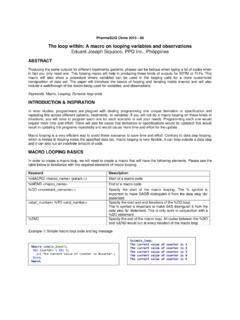Transcription of Probit Analysis By: Kim Vincent - San Francisco State ...
1 Probit Analysis By: Kim Vincent Quick Overview Probit Analysis is a type of regression used to analyze binomial response variables. It transforms the sigmoid dose-response curve to a straight line that can then be analyzed by regression either through least squares or maximum likelihood. Probit Analysis can be conducted by one of three techniques: o Using tables to estimate the probits and fitting the relationship by eye, o Hand calculating the probits, regression coefficient, and confidence intervals, or o Having a stastitical package such as SPSS do it all for you. Background The idea of Probit Analysis was originally published in Science by Chester Ittner Bliss in 1934.
2 He worked as an entomologist for the Connecticut agricultural experiment station and was primarily concerned with finding an effective pesticide to control insects that fed on grape leaves (Greenberg 1980). By plotting the response of the insects to various concentrations of pesticides, he could visually see that each pesticide affected the insects at different concentrations, one was more effective than the other. However, he didn t have a statistically sound method to compare this difference. The most logical approach would be to fit a regression of the response versus the concentration, or dose and compare between the different pesticides.
3 Yet, the relationship of response to dose was sigmoid in nature and at the time regression was only used on linear data. Therefore, Bliss developed the idea of transforming the sigmoid dose-response curve to a straight line. In 1952, a professor of statistics at the University of Edinburgh by the name of David Finney took Bliss idea and wrote a book called Probit Analysis (Finney 1952). Today, Probit Analysis is still the preferred statistical method in understanding dose-response relationships. The Basics Probit Analysis is a specialized regression model of binomial response variables. Remember that regression is a method of fitting a line to your data to compare the relationship of the response variable or dependent variable (Y) to the independent variable (X).
4 Y = a + b X + e Where a = y-intercept b = the slope of the line e = error term Also remember that a binomial response variable refers to a response variable with only two outcomes. For example: Flipping a coin: Heads or tails Testing beauty products: Rash/no rash The effectiveness or toxicity of pesticides: Death/no death Applications Probit Analysis is used to analyze many kinds of dose-response or binomial response experiments in a variety of fields. However, because my background knowledge of Probit Analysis stems only from toxicology, the examples from this webpage will only be of toxicology. Probit Analysis is commonly used in toxicology to determine the relative toxicity of chemicals to living organisms.
5 This is done by testing the response of an organism under various concentrations of each of the chemicals in question and then comparing the concentrations at which one encounters a response. As discussed above, the response is always binomial ( death/no death) and the relationship between the response and the various concentrations is always sigmoid. Probit Analysis acts as a transformation from sigmoid to linear and then runs a regression on the relationship. Once a regression is run, the researcher can use the output of the Probit Analysis to compare the amount of chemical required to create the same response in each of the various chemicals.
6 There are many endpoints used to compare the differing toxicities of chemicals, but the LC50 (liquids) or LD50 (solids) are the most widely used outcomes of the modern dose-response experiments. The LC50/LD50 represent the concentration (LC50) or dose (LD50) at which 50% of the population responds. For example, consider comparing the toxicity of two different pesticides to aphids, pesticide A and pesticide B. If the LC50 of pesticide A is 50ug/L and the LC50 of pesticide B is 10ug/L, pesticide B is more toxic than A because it only takes 10ug/L to kill 50% of the aphids, versus 50ug/L of pesticide B. How does Probit Analysis work? How to get from dose-response curve to an LC50?
7 Below you will find a step by step guide to using Probit Analysis with various methods. The easiest by far is to use a statistical package such as SPSS, SAS, R, or S, but it is good to see the history of the methodology to get a thorough understanding of the material. Step 1: Convert % mortality to probits (short for probability unit) Method A: Determine probits by looking up those corresponding to the % responded in Finney s table (Finney 1952): For example, for a 17% response, the corresponding Probit would be Additionally, for a 50% response (LC50), the corresponding Probit would be Method B: Hand calculations (Finney and Stevens 1948): The Probit Y, of the proportion P is defined by: The standard method of Analysis makes use of the maximum and minimum working probits: And the range 1/Z where Method C.
8 Computer software such as SPSS, SAS, R, or S convert the percent responded to probits automatically. Step 2: Take the log of the concentrations. This can either be done by hand if doing hand calculations, or specify this action in the computer program of choice. For example, after clicking Analyze, Regression, Probit , choose the log of your choice to transform: Step 3: Graph the probits versus the log of the concentrations and fit a line of regression. Note: Both least squares and maximum likelihood are acceptable techniques to fitting the regression, but maximum likelihood is preferred because it gives more precise estimation of necessary parameters for correct evaluation of the results (Finney 1952).
9 Method A: Hand fit the line by eye that minimizes the space between the line and the data ( least squares). Although this method can be surprisingly accurate, calculating a regression by hand or using computer program is obviously more precise. In addition, hand calculations and computer programs can provide confidence intervals. Method B: Hand calculate the linear regression by using the following method (Finney and Stevens 1948): First set the proportion responding to be equal to p = r/n and the complement equal to q = 1-p. The probits of a set value of p should be approximately linearly related to x, the measure of the stimulus, and a line fitted by eye may be used to give a corresponding set of expected probits, Y.
10 The working Probit corresponding to each proportion is next calculated from either of the following equations: Next a set of expected probits is then derived from the weighted linear regression equation of working probits on x, each y being assigned a weight, nw, where the weighting coefficient, w, is defined as: The process is repeated with the new set of Y values. The iteration converges to give you a linear regression. Method C: Use a computer program. SPSS uses maximum likelihood to estimate the linear regression. To run the Probit anaylsis in SPSS, follow the following simple steps: Simply input a minimum of three columns into the Data Editor Number of individuals per container that responded Total of individuals per container Concentrations For example in the following screen, a_mort is the number of individuals that responded per container, a_total is the total number of individuals per container, and a_conc are the concentrations.
